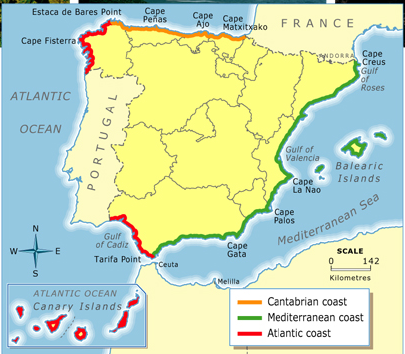
SPANISH COASTS, CAPES AND GULFS

A river is a body of moving water it starts high in the mountains and flows into sea, lake or another river.
The course is the route which a river takes.
The flow is the amount of water which a river carries.
LAKES AND RESERVOIRS
Lakes are large bodies of water surrounded by land.
Reservoirs are artificial lakes.
We use water from reservoirs to irrigate fields and for human consumption.
WATERSHEDS IN SPAIN
Watershed where all rivers flow in to the same sea.
There are three watersheds in Spain.
CANTABRIAN WATERSHED:
- It has rapid and short rivers.
- The flow is abundant and constant.
MEDITERRANEAN WATERSHED: (Except for Ebro River)
- It has short rivers.
- The flow is irregular.
- The flow is abundant and fairly regular.
LANDSCAPES
MOUNTAINS
MOUNTAINS are raised parts of the Earths's surface.
HILLS have lower altitude than mountains
Several mountains grouped togethere are called a MOUNTAIN RANGE. A long line of mountain ranges is called a MOUNTAIN CHAIN
VALLEYS are low areas between mountains. Rivers are often found in valleys.
PLAINS
They are large areas of flat lands with now hills or slopes.
A PLATEAU is a plain at a high altitude.
DEPRESSIONS are plains which are lower than the surrounding land.
COASTAL PLAINS are flat land near the coast.
THE COAST:
The coast is the place where the land meets the sea.
There are two types of coast:
LOW-LYING COASTS: They are plains by the sea. They have sandy beaches.
HIGH COASTS: They are high areas by the sea. They often have rocky cliffs.
LET'S THINK A MOMENT AND ANSWER THESE QUESTIONS:
- Where can you see a high coast in Spain?
- Where can you see a low-lying coast in Spain?
TYPES OF COASTLINES:
A CAPE: It is land which extends into the sea.
A GULF: It is a place where the sea extends into the land.
A PENINSULA: It is land which is almost completely surrounded by water.
AN ISLAND: It is land which is completely surrounded by water.
AN ARCHIPELAGO: It is a group of islands.
AN ESTUARY: It is a part of a river which opens into the sea.
A MARSH: It is wet land near the mouth of a river.



